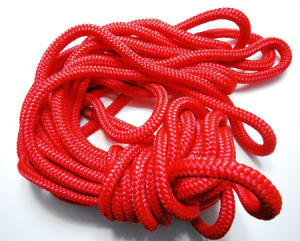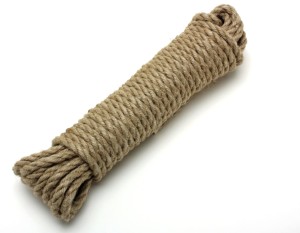I’ve talked a bit about rope safety and I have shown you a basic cuff weave but now what are you going to use to truss up your victim volunteer.
I’m going to talk about two of the main types of rope used; MFP and Hemp.
MFP or Multi Filament Polypropylene
MFP rope is my favorite, it is soft supple and can be found in any multitude of colors.
MFP can be found in what is known as no core meaning the rope is a solid braid and does not contain a core like some ropes.
This is particularly good in the fact that a rope with a core can stretch which if you are doing suspension would not be a good thing.
The person you are suspending could eventually end up on the floor as the rope stretches.
Multi Filament polypropylene rope should not be confused with MONO Filament Polypropylene which is what is commonly found in any hardware store. Mono Filament Propylene is a stiffer rope, is a plastic product and can be rough against the skin.
The nice part about the MFP rope is that it is low maintenance, it does not require a lot of care.
After use the rope can be easily washed by putting it in your washing machine and running it through a cycle.
The best way to do this is by putting the rope in a laundry/lingerie bag or even a pillow case.
I would hesitate to use hot water but warm would be fine for the rope.
Your favorite laundry detergent is fine to use and even a touch of bleach is alright to add as long as you do not add it directly to the water. Use bleach ONLY if you have a bleach dispenser that will dilute it before it comes in contact with the rope.
Once the rope is done washing you can put it in the dryer leaving it in the bag you washed it in.
It is alright to add a fabric softener sheet or two if you did not add any fabric softener to the wash.
Dry your rope on air fluff do not use any heat when drying.
The other nice thing about MFP rope is it is water proof, resistant to most chemicals, oils, and lubricants.
MFP rope can generally be found in two sizes 1/4 inch and 5/16 of an inch. The rope is tough, a 1/4″ MFP rope has a breaking load of 1300lbs while the 5/16″ has a breaking load 0f 2290lbs.
Cutting MFP is a fairly simple process, mark the rope at the point you want to cut it, using a lighter heat the rope at the area you want to cut. Once the rope has been heated using a pair of EMT scissors cut the rope. Cutting the rope with this method allows for a clean cut with the rope ends sealed.
All around MFP is a good rope, it sets a good knot but since it is supple the knots can be undone quickly if need be. Since each braid is usually died separately before being braided it is colorfast and you can get it in almost any color imaginable.
Hemp
Hemp is a natural fiber rope made from the cannabis plant. Hemp rope was used on sailing ships for it durability and strength but was commonly tarred to protect it from salt water.
Hemp rope is the most common rope used in the Japanese forms of rope tying such as Shibari, Kinbaku, and Hojojutsu.
Hemp rope is generally purchased in raw and unprocessed form and comes in its natural tan color. Processing and dying hemp rope can be done but it can be a very time consuming process. When done the rope can be supple and soft making it a good rope for tying and suspension.
Washing and cleaning hemp rope is done the same way as caring for MFP rope, be aware though that if your hemp rope is dyed that it is not color fast and the colors may run in the wash so only put it in there with no other clothes. Do not use bleach with hemp rope as that will take out the color and also harm the rope.
To dry hemp it should be hung to dry, do not put hemp rope in the dryer and be aware that it may well take several days for it to dry thoroughly.
Another consideration with hemp rope is it also should be inspected for any torn or loose fibers. When found those must be removed as they can very easily cause abrasions on the person you are tying. The easiest and most simple way to do this is to run the rope over a small flame and allowing them to burn off. Move the rope fast enough to only allow the loose fibers to burn off or you risk damaging the rope.
Once the rope is washed and any loose fibers removed; before it can be used it must be oiled to keep it supple and maintain it’s softness. Some people will use mink oil and others jojoba oil.
Store hemp rope in a cool dry place and avoid any direct sunlight as that will break the rope down quicker.
Hemp rope can be found in three common sizes 1/4″, 5/16″, and 3/8″. The break load of hemp is a little less then MFP; a 1/4″ of hemp has a break load of 570lbs, 5/16″ 900lbs, and 3/8″ 1410lbs.
Cutting hemp is a bit more complicated as well, once you cut the length of rope you desire it must be whipped. This is a process of tying the ends so they do not fray. If you buy the rope in pre-cut lengths most places will have it whipped for you.
If you have the time to care for your rope and are meticulous about it hemp can be a very good rope for any of your tying needs.
Happy tying!


